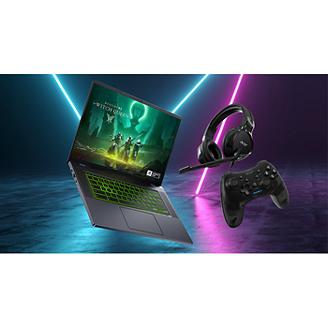-
Acer ProCreator PE0 and Upcoming ProCreator Line
Attention creators of the world! Forget 4K, step into the brilliant future of 6K Acer OLED monitors, namely the Acer ProCreator PE0 desktop monitor. Join us on our journey today, as we introduce this groundbreaking Acer desktop monitor designed strictly for creators. We’ll illustrate the many ways it can empower your creativity with ultra-sharp clarity, beyond life-like color accuracy, and of course flawlessly fluid motion. After we’ve given you the lowdown on the Acer ProCreator PE0, we’ll take a look at some of the other upcoming Acer monitors and portable projectors in the AcerProCreator family.
Designed to enhance creative workflows, Acer ProCreator Series monitors are Calman-verified, high-res displays. With select models in OLED and touchscreen, all ProCreator displays are AMD FreeSync Premium Pro and NVIDIA G-SYNC compatible. With wide color gamut coverage, up to Delta E<1 color accuracy levels, and the Acer Creator Hub software, ProCreator Series monitors also feature built-in webcams. The ProCreator family also includes portable, dual-screen foldable monitors, as well as compact LED projectors, perfect for a diverse range of applications.
Introducing the Acer ProCreator PE0
Creators know that color and clarity are key. Whether you’re a designer, animator, editor, or photographer, utmost precision in color accuracy combined with stunning visual clarity should be high on your list of must-haves when selecting a monitor. The Acer ProCreator PE0 ticks all the boxes for your creative projects, so let’s get into the nitty-gritty and check out all the features of this first-rate monitor so you know what you’ll be working with.
Picture perfect
The Acer ProCreator PE0 is a desktop display designed to maximize creative workflows, with Calman-verified, high-res 6K (6016 x 3384) resolution. Let the pixels work for you, not against you, emboldening your journey as you create, edit, and forge ahead with your work. 6K simply has to be seen to be believed, delivering precision, clarity, and depth to bring your work to hi-res life.
Outstanding OLED
In case you missed the memo, OLED is where it's at for displays today. The Acer ProCreator PE0 is technically a QD-OLED display (quantum dot organic light emitting diode). To better understand the function of this style of display, let’s quickly cover how the QD-OLED monitor works.
QD-OLED monitor technology uses an OLED panel in combination with quantum dots to create top quality images, tailored for creators. As you may know, in OLED display technology, each pixel generates its own light when the organic compounds are energised by electric current, resulting in high contrast ratios, vibrant colors and ultra deep blacks. In QD-OLED, light is provided by blue OLEDs, which are layered with quantum dots. These quantum dots convert portions of the blue light into red or green light, resulting in all of the sub pixels required for a full-color display. This quantum dot infusion adds even more life and accuracy to the colors you create with.
Certified colors
The Acer ProCreator PE0 features enough color credentials to make Vincent van Gogh blush with envy.
Firstly, Delta E <1 color accuracy means that this display is beyond accurate. The image color from the input (photo, video, etc), is displayed on the monitor, without any color distortion at all, generally considered imperceptible to the human eye. Next, Calman Verified color calibration ensures that what you see on the display is true to the original creation: every Acer ProCreator PE0 display is precisely tuned to Calman’s recommended technical color specifications and standards. Calman Verification guarantees reliable color performance and consistency for all creative workflows.
Finally, running the gamut of all colors, or the color gamut, is the range of colors that can be accurately displayed on a device. The ProCreator PE0 has 99% DCI-P3, as well as 99% Adobe RGB color gamut, ensuring that you’ll be the CEO of color accuracy with the PE0.
Frame by frame fluidity
Whatever form your creative process follows, invest in the Acer ProCreator PE0 and you’ll never need to think about lagging visuals again! With a 240Hz refresh rate, and an insanely rapid pixel response time of 0.01 ms, prepare for precise, uninterrupted visuals, delivering a viewing experience as smooth as your creative process. Furthermore, AMD FreeSync Premium Pro and NVIDIA G-SYNC compatibility offer silky-smooth, flicker-free visuals with a variable refresh rate.
Unleash your creativity
Further features at your fingertips include MPP 2.0 tilt-enabled stylus support for the touchscreen, enabling you to design, draw, sketch, and edit with natural precision, and panache. Finally, the Acer ProCreator PE0 is equipped with Acer Creator Hub, the software that beats all other creative software suites. Click into Acer Creator Hub to optimize your creative workflow with seamless multitasking, and split screen functionality, or choose the color space for each of your unique projects with the color space function. Or take things a step further with the Color Calibrator, where you can fine-tune colors with multiple profiles to tweak color temp, brightness, and even color space.
More ProCreator choices
Before we leave you, let’s have a brief peek at a couple of the other upcoming Acer ProCreator products. While the Acer ProCreator PE0 may be a tidy choice for your desk, some creators require the freedom of the open road, or a local cafe to ply their trade. But what if your creative process demands dual-screens?
This is where the Acer PD3 family of portable monitors come in. The Acer PD163QT and Acer PD243Y E are both dual-screen portable monitors with enviably wide viewing angles perfect for on-the-go creativity and multitasking. Full HD resolution, and foldable as far as 315° for presenting, reading, and collaborating, both of these portable monitors incorporate Acer VisionCare tech to keep your peepers comfortable during extended sessions. The PD163QT has touch capability for user-friendly, intuitive interaction, while the PD243Y E delivers smooth viewing thanks to its 100 Hz flicker-free refresh rate.
Finally, Acer’s PD1520Us is an insanely portable ultra-short-throw smart projector for anyone eager to project far and wide. Naturally, the PD1520Us has Full HD resolution projected on a 100-inch display with 44 cm projection distance, and 2,000 LED lumens. Weighing only 730-grams, the projector breaks through the boundaries of portable entertainment, transforming any room and surface into a full HD display.
Creativity on your own terms
We hope that you’ve enjoyed today’s voyage into the 6K world of Acer ProCreator PE0. Remember: your path to becoming the CEO of creativity begins with the PE0. Trust us, do yourself a favor and check out this display in the flesh. With a multitude of user-friendly features, and top-of-the-line resolution, color accuracy, and refresh rate, the Acer ProCreator PE0 is the monitor you need to take your creativity to the next level.
And lastly, don’t forget -if you’re interested in the other ProCreator Series monitors and space-saving LED projectors, check back for updates as they’re released from Q3 this year across the globe.
Recommended Products
Acer PD3 Dual-Screen Portable Monitor
Buy Now
Acer CS2 Smart Monitor 27"
Buy Now
-
Windows 11 Registry Editor Hacks to Improve Your PC's Performance
This article will show you how to use the Windows 11 Registry Editor to unlock hidden features, improve performance, and personalize your PC. The registry editor is a built-in tool that stores many of Windows’ low-level settings, from how menus look to how your system prioritizes tasks. While powerful, it should be used carefully, changing the wrong value can cause errors or instability. Before making any tweaks, it’s always a good idea to back up your computer so you can restore it if something goes wrong. Once you understand what the registry editor does and how to open it, you can safely try a few useful hacks to make your Windows 11 experience faster and more tailored to your needs.
What is the windows 11 registry editor and how does it work?
The Windows 11 registry editor is a built-in tool that lets you access the Windows Registry, a large database where the operating system stores all its configuration settings. Every change you make to your computer—installing software, changing wallpaper, adjusting network settings, or even disabling startup apps—creates or modifies entries in the registry. In short, the registry is what Windows uses to remember how your system is set up.
The registry editor is simply a way to view and edit these entries directly. Instead of relying only on the Settings app or Control Panel, you can use the registry editor to:
* Unlock hidden customization options.
* Adjust system performance settings.
* Turn off features you don’t use.
Because the registry holds core Windows instructions, edits apply immediately after you change them—no extra software is needed. But this also makes it risky: deleting or modifying the wrong value can cause apps to stop working, slow down your PC, or even prevent Windows from booting. For this reason, it’s recommended to back up the registry or create a system restore point before making changes.
In short, the Windows 11 registry editor is a powerful tool that works by giving you direct control over how the operating system behaves. When used carefully, it can help you customize your PC in ways that aren’t possible through the normal settings menus.
How to open registry editor in windows 11
There are several ways to open the Windows 11 registry editor, and all of them are straightforward.
Method 1: Using Run
* Press Windows key + R on your keyboard.
* Type regedit into the Run box.
* Press Enter or click OK.
* If prompted by User Account Control (UAC), select Yes to allow access.
Method 2: Using Windows Search
* Click the Start button or press the Windows key.
* Type Registry Editor into the search bar.
* Select Registry Editor (regedit) from the results.
* Confirm the UAC prompt to launch it.
Method 3: From Command Prompt or PowerShell
* Open Command Prompt or Windows PowerShell.
* Type regedit and press Enter.
Once opened, the registry editor will display a tree-like structure on the left, with folders called keys. These keys contain values and data that control how your system works. You can expand folders, navigate to specific paths, and double-click entries to modify them.
Always make a backup of your registry before editing. To do this, go to File > Export in the Registry Editor and save a copy of the entire registry or just the section you plan to change.
The dangers of tweaking the registry editor
Editing the Windows Registry Editor in Windows 11 gives you powerful control over system behavior, but it comes with serious risks if you make mistakes. The registry contains the instructions Windows relies on to run properly, so even small errors can lead to problems.
Some common risks include:
* System instability: Incorrect changes can cause apps to crash or Windows to behave unpredictably.
* Startup failures: Deleting or altering critical keys may prevent Windows from booting at all.
* Lost settings: Modifying the wrong entry can reset or disable features unintentionally.
Because of these risks, it’s essential to create a safety net before making any edits. At minimum, you should back up your computer or export the specific registry keys you plan to change. This way, if something goes wrong, you can restore your system to a working state.
Useful registry editor hacks for Windows 11
Now that you know what the registry editor is and how to open it safely, here are some practical tweaks that can make your PC feel faster or more personalized.
1. Disable network throttling
By default, Windows limits network bandwidth for certain background tasks. This can slow down online gaming or video streaming. Disabling network throttling can help ensure your network speed is fully available.
Path: HKEY_LOCAL_MACHINE\SOFTWARE\Microsoft\WindowsNT\CurrentVersion\Multimedia\SystemProfile
* Find the key NetworkThrottlingIndex.
* Double-click it and set the value to ffffffff (eight f’s).
* Click OK and restart your PC.
This allows Windows to use maximum network bandwidth without artificial limits.
2. Disable Bing search in the Start menu
Windows 11 integrates Bing into Start menu searches, which can feel unnecessary if you only want local results. Disabling Bing can make searches faster and more private.
Path: HKEY_CURRENT_USER\Software\Microsoft\Windows\CurrentVersion\Search
* If the Explorer key doesn’t exist, right-click Windows and select New > Key, then name it Explorer.
* Inside Explorer, right-click and create a new DWORD (32-bit) Value called DisableSearchBoxSuggestions.
* Set its value to 1 and restart your PC.
Now Start menu searches will only show local files and apps, not web results.
3. Restore the old right-click context menu
Windows 11 introduced a simplified right-click menu, but some users prefer the classic full menu. This tweak restores the old style.
Path: HKEY_CURRENT_USER\Software\Classes\CLSID
* Right-click CLSID and select New > Key.
* Name the new key: {86ca1aa0-34aa-4e8b-a509-50c905bae2a2}
* Inside it, create another key named InprocServer32.
* Leave the default value empty.
After restarting, you’ll see the classic right-click menu again.
4. Disable the lock screen
If you don’t want to see the lock screen every time you start your PC, you can disable it with a registry edit.
Path: HKEY_LOCAL_MACHINE\SOFTWARE\Policies\Microsoft\Windows\Personalization
* If the Personalization key doesn’t exist, create it.
* Inside, create a new DWORD (32-bit) Value called NoLockScreen.
* Set the value to 1.
The next time you start or lock your computer, Windows will take you straight to the login screen.
5. Add seconds to the system clock
By default, Windows 11 shows only hours and minutes in the taskbar clock. If you want more precision, you can enable seconds.
Path: HKEY_CURRENT_USER\Software\Microsoft\Windows\CurrentVersion\Explorer\Advanced
* Find or create a DWORD (32-bit) Value named ShowSecondsInSystemClock.
* Set its value to 1.
* Restart Windows Explorer or your PC to see seconds appear in the taskbar clock.
This tweak is useful if you need exact time tracking without opening another app.
6. Reduce resource allocation to background tasks
Windows 11 often gives system resources to background services, which can affect performance in games or demanding applications. You can adjust this balance so more resources go to the foreground.
Path: HKEY_LOCAL_MACHINE\SOFTWARE\Microsoft\Windows NT\CurrentVersion\Multimedia\SystemProfile
* Find the key SystemResponsiveness.
* Double-click it and set the value to 0.
This ensures Windows prioritizes active tasks over background services, improving responsiveness in performance-heavy scenarios.
7. Disable Windows Copilot
Some users find Windows Copilot unnecessary or prefer not to have it running in the background. You can turn it off through the registry.
Path: HKEY_CURRENT_USER\Software\Policies\Microsoft\Windows
* Right-click Windows and create a new key called WindowsCopilot (if it doesn’t exist).
* Inside, create a new DWORD (32-bit) Value named TurnOffWindowsCopilot.
* Set its value to 1.
After restarting, the Windows Copilot button will no longer appear on the taskbar, and the feature will be disabled.
Final thoughts and best practices
The Windows 11 registry editor gives you direct control over how your PC looks, feels, and performs. With the right tweaks, you can remove unnecessary features, improve responsiveness, and personalize your system in ways that aren’t possible through standard settings. The hacks we’ve covered, from disabling Bing search to adjusting system resource allocation, are safe when applied carefully and can make your Windows 11 experience smoother.
That said, the registry is a critical part of Windows. Always create a backup or system restore point before making changes, and only edit keys you fully understand. If you encounter issues, restoring your backup will quickly undo any mistakes.
By following best practices and applying these registry editor hacks responsibly, you’ll be able to unlock hidden functionality in Windows 11 while keeping your system stable and reliable.
Recommended Products
Swift X 14
Buy Now
Aspire 14 AI
Buy Now
-
How to Back Up a Windows 10 PC Before Upgrading to Windows 11
If you are still running Windows 10, now is the time to prepare for the upcoming end of service (EOS) in October 2025. Creating a Windows backup now, while your PC is still on Windows 10, ensures you capture your current system exactly as it is before upgrading to Windows 11 or replacing your device. A proper computer backup keeps your personal data safe, easy to restore, and ready to transfer to a new system if needed.
Why backups are important before Windows 10 EOS
When Microsoft ends support for Windows 10, security updates will stop, which will make your system more vulnerable to malware and cyberattacks. If you plan to upgrade to Windows 11, things can still go wrong during the process such as failed installations, corrupted files, or compatibility issues that can leave you with missing data.
That is why a data backup and recovery plan is essential. By saving your documents, photos, videos, and other important files in advance, you protect yourself from accidental loss and make it easier to move your data to a new PC. If your current device cannot run Windows 11, you can still create a full system backup on Windows 10 and then restore everything on a replacement computer.
What should you back up
Before upgrading, focus on creating a data backup of your most important files. These are the items you will want to access immediately after moving to Windows 11 or setting up a new computer.
* Documents – Word files, PDFs, spreadsheets, and other work or school materials.
Photos and videos – Personal photos, project videos, and any media that is not stored in a cloud service.
* Music and audio files – Songs, recordings, and podcasts stored locally.
Emails and contacts – Export from your email client if you use Outlook or other desktop-based programs.
* Downloads – Any installers, invoices, or digital receipts you may need later.
* Custom folders – Game save files, design projects, code repositories, and other personal work.
In addition to personal files, consider making a Windows backup of your system settings and application data. This ensures that your software preferences, desktop layout, and other custom configurations can be restored if something goes wrong during the upgrade.
How to back up on Windows 10
There are several ways to create a Windows backup before upgrading to Windows 11. The best approach is to use more than one method so your files are protected in different locations.
1. Use OneDrive for cloud backup
OneDrive is Microsoft’s built-in cloud storage service that comes with all Microsoft accounts. It automatically saves your files online so you can access them from any device.
* Sign in to your Microsoft account on your Windows 10 PC.
* Select the OneDrive cloud icon in the taskbar.
* Go to Settings > Sync and backup > Manage backup.
* Turn on backup for Desktop, Documents, Pictures, Music, and Videos.
* Wait for files to fully sync before starting your Windows 11 upgrade.
Using OneDrive is one of the simplest data backup and recovery methods because your files remain safe even if your PC fails during the upgrade.
2. Copy files to an external drive
An external hard drive or USB drive is an easy and reliable computer backup option.
Option 1: Manual copy
* Connect your external drive to your PC.
* Open File Explorer and select the folders you want to save, such as Documents, Pictures, and Videos.
* Copy them to the external drive.
* Safely eject the drive and store it in a safe place.
This method does not rely on an internet connection and gives you physical control over your data back up.
Option 2: Use File History for automatic backups
Windows 10 includes a feature called File History that can automatically save copies of your files to an external drive.
* Go to Settings > Files backup.
* Select Add a drive and choose your external drive.
* Click More options to set how often files are backed up and how long versions are kept.
With File History, you can restore previous versions of files or recover deleted items without having to copy everything manually.
3. Create a full system backup with Windows 10’s Backup and Restore tool
Windows 10 includes a built-in backup feature called Backup and Restore. In the Control Panel it appears as “Backup and Restore (Windows 7),” but it works perfectly on Windows 10. You can use it to create a complete system image, which is helpful if you need to roll back to Windows 10 after upgrading.
* Open the Control Panel and under System and Security select Backup and Restore (Windows 7).
* Click Create a system image from the left menu.
* Choose your external drive as the backup location.
* Follow the prompts to complete the process.
A system image contains all your files, settings, and installed programs, so you can restore your entire PC to exactly how it was before the upgrade.
Remember the Windows 10 end of service date
Microsoft will end support for Windows 10 in October 2025. If you create a Windows backup now, you will be ready to upgrade or replace your PC without risking data loss. Some users can get a free extra year of security updates. Follow this guide on how to get free extended security updates for Windows 10 to see if you qualify.
If your computer cannot run Windows 11, consider buying a new Acer device and transferring your files from your backup.
Before you finish, take these two final steps to make sure your backup is truly ready:
* Verify your backup – Open your external drive or cloud folder and check that your documents, photos, and other key files open correctly. This ensures your data backup and recovery process will work if you ever need it.
* Create a recovery drive – In Windows 10, search for “Create a recovery drive” in the Start menu. Use a blank 16 GB or larger USB drive, and make sure “Back up system files to the recovery drive” is checked. This gives you a bootable tool to fix startup problems or restore your PC if the upgrade fails.
By completing these steps now, you protect your files, reduce the risk of upgrade issues, and make the move to Windows 11 or a new PC as smooth as possible.
Recommended Products
Swift X 14
Buy Now
Aspire 14 AI
Buy Now
-
HDMI 2.2 vs 2.1 for Gaming: Specs and Release Date
HDMI 2.2 is the newest update to the High-Definition Multimedia Interface, doubling the bandwidth of HDMI 2.1 and promising higher refresh rates, better latency performance, and future-proof cables for next-generation gaming setups. In this guide, we’ll break down exactly what HDMI 2.2 is, how it compares to HDMI 2.1, when it’s coming out, and whether it’s worth upgrading for gaming.
What is HDMI 2.2?
HDMI 2.2 is the newest HDMI standard, officially announced at CES on January 6, 2025, and expected to roll out in the second half of the year. It is designed to meet the growing demands of ultra-high-resolution and ultra-high-refresh-rate displays, particularly in gaming, virtual reality, and professional applications.
The most notable upgrade is bandwidth. HDMI 2.2 doubles the capacity of HDMI 2.1 from 48 Gbps to 96 Gbps. This allows it to support extreme display modes such as 4K at 480Hz, 8K at 240Hz, 10K at 120Hz, and in certain configurations up to 12K at 120Hz or 16K at 60Hz. It also introduces the Latency Indication Protocol (LIP), which improves audio-video synchronization and reduces delays between controller input and on-screen response.
To take advantage of HDMI 2.2, you will need new Ultra96 HDMI cables certified to handle the full 96 Gbps bandwidth. These cables will be part of the HDMI Cable Certification Program and include a certification label to confirm performance.
HDMI 2.2 pushes display technology to new limits, although its full benefits will mainly be felt in high-end, future-ready setups rather than in most current gaming systems.
HDMI 2.2 specs
HDMI 2.2 builds on the foundation of HDMI 2.1 with major improvements in bandwidth, resolution, refresh rate, and latency performance. Below are the key specifications.
HDMI 2.2 vs HDMI 2.1
HDMI 2.1 was a major step forward for gaming when it launched, introducing Variable Refresh Rate (VRR) to eliminate screen tearing, Auto Low Latency Mode (ALLM) to reduce input lag, and support for resolutions up to 8K at 60Hz or 4K at 120Hz. These features made it ideal for both next-generation consoles and high-end PC gaming setups.
HDMI 2.2 builds on that foundation with double the bandwidth, jumping from 48 Gbps to 96 Gbps. This means twice the data can be transferred every second, which is crucial for driving higher resolutions at much higher refresh rates without sacrificing image quality. With this extra headroom, HDMI 2.2 can handle formats like 4K at 480Hz or 8K at 240Hz without relying as heavily on compression technologies such as Display Stream Compression (DSC).
Another key improvement is the introduction of the Latency Indication Protocol (LIP), which provides real-time latency data to help devices better synchronize audio, video, and input signals. This can be especially beneficial for competitive gamers, VR users, and anyone sensitive to input delay.
Finally, HDMI 2.2 requires the use of new Ultra96 HDMI cables that are certified to handle the full 96 Gbps bandwidth. This ensures consistent performance at these extreme settings, something that was more challenging to guarantee with older cable standards.
For most gamers, HDMI 2.1 still meets today’s demands. But HDMI 2.2 is clearly aimed at the future, where ultra-high refresh rates, 8K and beyond, and latency-critical applications like VR become mainstream.
What does this mean for gaming?
On paper, HDMI 2.2’s specs sound like a dream for gamers — 4K at 480Hz, 8K at 240Hz, and even 10K to 12K resolution support. In reality, no modern gaming setup can take full advantage of those numbers. Even the most powerful GPUs today, like the RTX 5090 or Radeon 9900 XTX, cannot drive 10K or 12K gaming at playable frame rates in modern AAA titles.
However, that does not mean HDMI 2.2 is irrelevant for gaming in 2025. There are three key benefits gamers can expect:
* Better Refresh Rates
For competitive esports players and high-refresh gaming enthusiasts, HDMI 2.2’s ability to handle 4K at up to 480Hz and 8K at 240Hz means smoother motion and reduced motion blur in future monitors.
* Lower Latency with LIP
The Latency Indication Protocol helps improve audio-video sync and can reduce controller input lag, which is especially valuable for fast-paced shooters and competitive fighting games.
* Future-Proofing
Even if your current setup cannot use HDMI 2.2’s full capabilities, buying a monitor or GPU with HDMI 2.2 support ensures you are ready for the next generation of display technology. The new Ultra96 HDMI cables are also built to handle higher bandwidth, making them more durable for long-term use.
Should you buy it now?
For most gamers, the answer is no. HDMI 2.1 already supports 4K at 120Hz, 8K at 60Hz, and features like Variable Refresh Rate (VRR) and Auto Low Latency Mode (ALLM), which cover the needs of nearly all current gaming setups. If you are gaming at 1080p, 1440p, or even 4K on a 120Hz display, HDMI 2.2 will not give you a noticeable improvement right now.
For extreme high-end builds, it is a different story. If you have or plan to build a PC with something like an AMD Ryzen 9800X3D and an Nvidia RTX 5090, or you are investing in early-release 4K 480Hz or 8K 240Hz monitors, HDMI 2.2 could be worth considering for future-proofing. You would also be ready to take advantage of new Ultra96 HDMI cables and their improved bandwidth capacity.
It is important to remember that very few GPUs today can reliably run games at 8K, let alone higher resolutions, without relying on upscaling technologies like DLSS or FSR. Even with an HDMI 2.2 cable, you cannot fully utilize its maximum capabilities unless both your GPU and display can handle the required output.
In short, average gamers can safely stick with HDMI 2.1 for the next few years, while hardware enthusiasts who want to be ready for the next generation of display tech may see value in upgrading early.
Final thoughts on HDMI 2.2 and the future of gaming
HDMI 2.2 is a significant leap forward in display technology, doubling the bandwidth of HDMI 2.1 to 96 Gbps and enabling extreme modes like 4K at 480Hz, 8K at 240Hz, and even up to 12K or 16K in certain configurations. Features such as the Latency Indication Protocol improve audio-video sync and can reduce controller input lag, making it appealing for competitive gaming and immersive experiences.
However, these capabilities are far ahead of what most gaming hardware can deliver today. Very few GPUs can reliably output native 8K gaming, and virtually none can push 10K or 12K without major compromises. For now, HDMI 2.1 remains more than adequate for the vast majority of gamers, providing high refresh rates, 8K support, and essential gaming features.
HDMI 2.2’s true value lies in future-proofing. Early adopters with cutting-edge PCs and next-generation displays may benefit sooner, but for most, waiting until compatible devices and GPUs become widespread will make far more sense.
Recommended Products
Acer SpatialLabs View Pro 27 Monitor
Buy Now
Predator SpatialLabs View 27 Monitor
Buy Now
-
Why Acer Laptops Are Perfect for College Students in 2025: A Buyer's Guide
Choosing the best laptops for college students can feel overwhelming when balancing performance needs against tight budgets. College life demands a reliable computing companion that won't quit during marathon study sessions or break the bank. Acer laptops have emerged as standout options for students heading to campus in 2025, offering an impressive combination of affordability, durability, and performance.
Whether you're taking notes during lectures, working on assignments at the library, or unwinding with games after finals, Acer provides a diverse lineup that caters to various academic needs. Furthermore, their range spans from budget-friendly Aspire models to powerful Swift ultrabooks, essentially covering every student scenario. This guide examines why Acer laptops deserve consideration as your academic companion, breaks down the most suitable models for different majors, and compares them against competing brands to help you make an informed decision before heading to campus.
Why Acer Laptops Fit College Life in 2025
In the fast-paced environment of higher education, your laptop choice can significantly impact your academic success. Acer stands out in 2025 as a brand that truly understands student needs, offering devices that combine cutting-edge technology with practical features designed specifically for campus life.
Lightweight designs for easy portability
Moving between dorm rooms, lecture halls, and study spots requires a laptop that won't weigh you down. Acer has mastered the art of creating lightweight yet durable devices that slip easily into backpacks. The Swift family exemplifies this philosophy with ultraportable designs weighing under 4 pounds. The Swift 14 AI, for instance, weighs a mere 2.91 pounds while still delivering impressive performance.
The brand's commitment to portability extends across various price points. Even their more affordable models maintain slim profiles without sacrificing durability. The Swift series particularly shines with expertly crafted premium designs that are "thin, light, and perfect for go-getters on the move". Many models feature sleek aluminum construction that adds a touch of style while enhancing durability—an important consideration for the sometimes chaotic college lifestyle.
Additionally, Acer's focus on compact designs means most of their student-friendly laptops feature screen sizes between 14 to 15.6 inches, offering the ideal balance between usable screen real estate and portability. This thoughtful sizing means you'll have enough screen space for multitasking without lugging around an unnecessarily large device.
Long battery life for all-day use
Nothing disrupts productivity like a dying laptop in the middle of an important lecture. Acer addresses this common student frustration with impressive battery performance across their lineup. Many models offer 10+ hours of battery life, ensuring you can make it through a full day of classes without hunting for an outlet.
Some standout performers in the battery department include:
The Swift 14 AI with Qualcomm Snapdragon X Series CPU, which delivers an astonishing 26 hours of battery life on a single charge. Similarly, the Swift 14 AI with AMD Ryzen AI CPU matches this 26-hour runtime. For those seeking ultimate endurance, the Swift 14 AI with Intel processors provides up to 29 hours of video playback.
Even Acer's more budget-conscious options offer respectable battery performance. The Aspire Go 15, for example, provides approximately 12 hours of runtime, while the Swift X 14 also manages 12 hours unplugged. This emphasis on battery longevity means you can confidently leave your charger at home for most school days.
Affordable options for student budgets
Perhaps most importantly for college students, Acer offers exceptional value at various price points. The brand has established itself as a go-to option for budget-conscious shoppers without compromising essential performance.
The Acer Aspire series represents excellent entry-level options, with models like the Aspire Go 15 priced at just $299 while still providing decent battery life and good display visibility. For those with slightly higher budgets, the Aspire 14 AI offers AI capabilities at a reasonable $1,049.99.
At the same time, Chromebooks provide another affordable pathway, with models like the Chromebook Plus 514 offering "surprisingly good display and performance for the price". These Chrome OS devices run efficiently even with less powerful processors, making them perfect for students focusing on research, writing, and online coursework.
As a result, Acer consistently delivers laptops that maximize value while meeting the essential requirements of college life: portability, longevity, and affordability.
Top Acer Laptop Series for Students
Acer offers a diverse range of laptop series, each designed to address specific student needs without stretching tight college budgets. From basic note-taking to intensive graphic design projects, these specialized lineups cater to various academic requirements and personal preferences.
Aspire: Budget-friendly and reliable
The Aspire series stands as Acer's cornerstone for affordability combined with dependable performance. The Aspire Go 15, priced at just $299, delivers approximately 12 hours of battery life with decent display visibility—perfect for students prioritizing value. The newly released Aspire 14 AI elevates the experience with Intel Core Ultra 7 processors and 1TB SSD storage while maintaining a reasonable $1,049.99 price point. For environmentally conscious students, the Aspire Vero 16 incorporates post-consumer recycled plastics, including an OceanGlass touchpad made from ocean-bound plastic. These laptops handle essential academic tasks efficiently, making them ideal first-time college computers that won't break the bank.
Swift: Lightweight and performance-focused
The Swift series embodies premium ultraportable design without sacrificing power. Notably, the Swift 14 AI weighs just 2.91 pounds while delivering impressive battery performance—up to 26 hours on select models. The Swift X 14 caters to creative students with its NVIDIA GeForce RTX 4060 GPU with 8GB dedicated memory, perfect for design projects and light gaming. Meanwhile, the Swift Go 14 has earned recognition as the "Best Light Laptop for College" from PCMag, weighing only 2.76 pounds with nearly 16 hours of battery life. Consequently, these sleek devices make excellent companions for students constantly moving between classes, libraries, and study sessions.
TravelMate: Built for productivity and business
Originally designed for business professionals, the TravelMate series has found a niche among serious-minded students. The TravelMate P4 combines robust performance with military-grade durability (MIL-STD-810H certified), featuring extended battery life of up to 9 hours. In educational settings, these laptops have proven particularly valuable—a UK pilot program demonstrated how TravelMate devices enhanced learning experiences for students with special educational needs. Furthermore, the TravelMate Spin P4 offers versatility with its touchscreen capability and 14" WUXGA display, making it ideal for design students or those who prefer stylus input.
Chromebooks: Great for web-based tasks
Acer's Chromebook lineup offers affordable options running Google's lightweight Chrome OS. The Chromebook Plus Spin 714 has been recognized as "the best Chromebook for students" by RTings, featuring a sturdy build, compact design, and battery that lasts through a typical school day. Because Chrome OS requires fewer resources than Windows, these devices deliver smooth performance even with more modest specifications. Most importantly, Chromebooks typically cost less than comparable Windows laptops while offering simpler interfaces ideal for students focused primarily on research, writing, and web-based applications. The compromise comes with limited software compatibility, making them best suited for non-specialized majors.
Nitro: Entry-level gaming and creative work
The Nitro series bridges academic productivity with gaming capabilities. The Nitro V 15 provides "surprisingly smooth 1080p gaming performance for less than $1000," according to PCMag. Powered by options like the 12th Gen Intel Core i7-12700H processor paired with NVIDIA GeForce RTX 3070Ti graphics, these laptops handle both demanding engineering applications and recreational gaming. The Nitro 16 features a 165Hz refresh rate display, making it suitable for competitive gamers and multimedia students alike. The trade-off comes with reduced battery life—typically around 4 hours under standard use—requiring students to keep power sources nearby.
Best Acer Laptops by Student Type
Different academic paths demand specialized computing solutions. Finding the perfect match between student needs and laptop capabilities can make a substantial difference in academic success. Let's explore the ideal Acer laptops for various student profiles in 2025.
For general use: Acer Swift Go 14
The Swift Go 14 excels as an all-purpose academic companion with its blend of portability and performance. Weighing just under three pounds, it offers exceptional mobility between classes. The laptop delivers impressive battery life, lasting approximately 11 hours during light use - sufficient for a full day of lectures and study sessions.
What truly distinguishes this model is its display options, including a vibrant 2.8k OLED panel with 90Hz refresh rate that makes both study materials and entertainment content look outstanding. Powered by Intel Meteor Lake CPUs, it handles multitasking effortlessly while remaining cool and quiet - perfect for library environments.
For creative majors: Acer Swift X 14
Creative students require additional graphics power, which is precisely what the Swift X 14 delivers. Equipped with an NVIDIA GeForce RTX 4060 with 8GB dedicated memory, this laptop handles demanding applications like video editing and 3D modeling with ease.
Its standout feature is the impressive 2.8K OLED display with 100% DCI-P3 color coverage and Calman Verified calibration, providing exceptional color accuracy for design work. Despite its powerful components, it maintains impressive 12-hour battery life, ensuring creative sessions aren't interrupted by frequent charging.
For gamers: Acer Nitro V 16
Students who balance academics with gaming will appreciate the Nitro V 16's capabilities. Available with options up to an NVIDIA GeForce RTX 4060 GPU and either Intel Core Ultra or AMD Ryzen processors, it delivers smooth gaming performance without breaking the bank.
Its 16-inch WQXGA display offers up to 165Hz refresh rate with 100% sRGB color coverage, providing both gaming fluidity and color accuracy for projects. Battery life remains the main compromise at around 4-5 hours under typical use.
For budget-conscious students: Acer Aspire 3 Spin 14
The Aspire 3 Spin 14 represents excellent value with its versatile 2-in-1 design. Its 360° hinge allows use in laptop, tablet, or presentation modes - ideal for note-taking and group projects. The 14-inch touchscreen supports stylus input, enhancing its versatility for both note-taking and creative tasks.
Built around Intel Core i3 N-Series processors with 8GB RAM, it offers reliable performance for everyday academic tasks while remaining affordable at around $440-550.
For ChromeOS users: Chromebook Plus Spin 714
The Chromebook Plus Spin 714 offers exceptional value for students primarily using web applications. Its military-grade durability (MIL-STD 810H certified) ensures it survives campus life.
The bright 340-nit display with 100% sRGB coverage looks vibrant while maintaining excellent battery life of over 10 hours. Its 1440p webcam provides outstanding image quality for video calls, though the microphone quality is merely adequate. Overall, it delivers premium features at a reasonable price point.
How Acer Compares to Other Brands
When shopping for college laptops, understanding how brands compare helps you make a smarter choice. Acer has carved out a distinct position against major competitors, offering unique advantages for students with different needs and budgets.
Acer vs HP: Better value at mid-range
Comparing these two popular brands reveals a clear pattern: HP generally produces more premium models with additional workstation and business offerings. However, Acer's mid-range and budget models typically provide superior value, delivering better user experience and performance at lower price points. This advantage is particularly evident in models like the Acer Aspire 3, which offers snappy processing, Wi-Fi 6 support, and impressive battery life—lasting nearly 17 hours—all for under $500.
Acer vs Lenovo: More straightforward configurations
Unlike Lenovo, which often assigns multiple names to the same laptop and offers numerous configuration options that can be confusing, Acer maintains a more straightforward product lineup. Nevertheless, Lenovo laptops generally feel sturdier, as seen in comparisons between the Acer Aspire 3 and Lenovo IdeaPad 3, where the Lenovo's build quality feels more robust. For students seeking simplicity in their purchasing decision, Acer's more transparent options prove beneficial.
Acer vs Apple: More affordable and versatile
The contrast between these brands is stark—Acer produces a wide range of Windows and Chrome OS models at various price points, including productivity and gaming laptops. Apple exclusively makes premium productivity devices. Although Apple laptops generally offer superior build quality and user experience, they come with significantly higher price tags. This affordability gap makes Acer an attractive option for budget-conscious students needing versatile computing solutions.
Acer vs ASUS: Competitive in budget and mid-tier
Both brands compete fiercely in the student laptop market. Acer excels by delivering excellent performance at more accessible prices, particularly in the budget to mid-range segment (under $600). ASUS, conversely, dominates the mid to high-end market with premium features but at higher prices. For most college students focusing on browser-based work or document-heavy tasks, Acer offers the better value proposition, though ASUS might appeal more to gamers and creative students requiring advanced GPUs and display quality.
What to Consider Before Buying an Acer Laptop
Making a smart investment in your college laptop requires thorough research beyond just brand comparisons. First of all, a successful purchase depends on several key considerations.
Check your college's tech requirements
Begin by reviewing your institution's specific laptop recommendations. Visit your college IT department's website or search for "[college name] + [department] + laptop requirements". Many engineering programs require laptops capable of running complex simulations, whereas other majors may have simpler needs.
Decide between Windows and ChromeOS
Windows offers broader software compatibility, reducing course-required software incompatibility issues. Alternatively, ChromeOS provides seamless integration with Google services and typically delivers longer battery life. Your major's software requirements should guide this decision.
Choose the right screen size and weight
For maximum portability, select laptops weighing less than 4 pounds with screen sizes between 13-15 inches. This balance ensures comfortable viewing while remaining light enough for daily campus transport.
Look for upgradeable storage and RAM
Media-heavy disciplines require at least 1TB of storage or expandable options. Prioritize SSD storage for speed and durability. Consider models with 16GB RAM for optimal long-term performance. Verify if your chosen Acer model supports future RAM upgrades.
Consider warranty and support options
Check if your university offers special support or discounts through school partnerships. Acer provides extended warranty options, including Premier Support programs with dedicated technical assistance.
Conclusion
Choosing the right laptop represents a crucial decision for academic success in 2025 and beyond. Acer stands out as an excellent choice for college students thanks to its impressive combination of portability, battery endurance, and budget-friendly options. The diverse lineup from Aspire to Swift to Nitro ensures students from all majors can find a suitable match without overspending.
Before making your final decision, carefully evaluate your specific course requirements and computing needs. Students pursuing graphic design might benefit from the Swift X 14's powerful GPU, while those primarily writing papers could save significantly with an Aspire model or Chromebook. Battery life should remain a priority for anyone expecting long days on campus without reliable access to outlets.
Compared to competitors, Acer consistently delivers better value, especially in the mid-range market. Though Apple and high-end ASUS models might offer premium build quality, Acer provides the essential performance most students need at much more accessible price points.
Ultimately, your Acer laptop serves as an investment in your education rather than just another expense. The right choice will support your academic journey throughout your college years. Many models offer future-proofing through upgradeable components, therefore extending their useful lifespan even as software demands increase. With thoughtful consideration of your specific needs, an Acer laptop can become your reliable academic companion from freshman orientation through graduation day.
-
Acer Nitro 16 AI: Copilot+ PC Budget Gaming Laptop
With a powerful NVIDIA® GeForce RTX™ 5070 Ti Laptop GPU, the Acer Nitro 16 AI Copilot+ PC is a sophisticated mix of enhanced speed and smooth visuals. It includes advanced cooling, high core counts, high clock speeds, and a large on-chip memory for intense gaming sessions. With increased power efficiency and AI processing, the Nitro 16 AI Copilot+ PC is an excellent choice for gamers on a budget.
What is a Copilot+ PC?
Copilot+ PCs are supported by a turbocharged neural processing unit (NPU) that is able to perform over 40 trillion operations per second (TOPS). They also include other features like a Microsoft Pluton security processor and automatic super resolution, and perform AI-intensive processes on the device rather than via Microsoft’s servers. The Recall feature lets users quickly locate information on their PC using a description, while AI-powered image editing uses text prompts to transform images.
Acer Nitro 16 AI specifications
* Processor: up to AMD Ryzen™ AI 9 365 processor (50 TOPS)
* Graphics Processing Unit (GPU): Up to NVIDIA® GeFORCE RTX™ 5070 Ti
* Max Graphics Power (MGP): up to 115W with Dynamic Boost
* Memory: 8 GB
* Storage: Up to 2 TB
* Ports: 3x USB 3.2 Gen 1 Type-A, 2x USB 3.2 Gen 1 Type-C, Ethernet, 3.5-mm audio jack, 1x HDMI 2.1
* Wireless: Intel Wi-Fi 6E, Bluetooth 5.3
* Dimensions: 14.05 x 10.85 x 0.48 - 0.79 inches (35.68 x 27.55 x 1.21 - 2.0 cm)
* Display: WQXGA 2560 x 1600, up to 180Hz refresh rate, up to sRGB 100% Wide Color Gamut
* Other: 5th Gen Tensor Cores max AI performance with FP4 & DLSS 4
Features
The Nitro 16 AI Copilot+ PC offers an exciting world of generative AI-powered tools and digital assistants, resulting in an outstanding elite gaming performance and intelligent computing.
1. Game-changing 5070 Ti GPU
The 5070 Ti GPU offers superior performance, transforming how gamers play and create. With 992 AI TOPS and 5th Generation Tensor Cores that accelerate throughput while offering enhanced security, the 5070 Ti GPU includes built-in AI processors that give gamers cutting-edge technology at their fingertips. It has a memory configuration of 12GB GDDR7 and boasts 5,888 CUDA cores for ultimate gaming performance. Moreover, the 5070 Ti Gpu’s game frame rates are twice as fast as that of the GeForce RTX 5070 Ti. This means that gamers can play games like Cyberpunk 2077 and Black Myth: Wukong with a performance of 1080p and 1440p, and enjoy 3 months free access to PC Game Pass and EA Play. Having such a powerful 5070 Ti GPU in a laptop like the Nitro 16 AI Copilot+ PC is outstanding value for money, as users can benefit from smoother frame rates and seamless performance at a budget-friendly cost.
2. DLSS 4 backed by a NVIDIA AI supercomputer
DLSS is a range of neural rendering technologies that utilize AI to boost FPS, reduce latency, and enhance image quality. The groundbreaking DLSS 4 provides Multi Frame Generation and impressive Ray Reconstruction and Super Resolution with GeForce RTX™ 50 Series GPUs and fifth-generation Tensor Cores. Moreover, DLSS on GeForce RTX is backed by a cloud-based NVIDIA AI supercomputer and is fully supported by the 5070 Ti GPU, ensuring an out-of-this-world gaming experience.
3. Full ray tracing with neural rendering
Experience game-changing realism with NVIDIA Blackwell architecture and full ray tracing. GeForce RTX™ 50 Series with fourth-gen RT Cores and advanced neural rendering technologies with fifth-gen Tensor Cores provide lightning-fast visuals, and are enhanced by the 5070 Ti GPU.
4. Compete at a rapid pace with Reflex 2
The 5070 Ti GPU ensures a superior graphics pipeline with quicker reaction times and enhanced aim precision while gaming, while the Frame Warp reduces latency for a seamless gaming experience, helping you come out on top in competitive games.
5. World-class NVIDIA AI
Up your gaming skills and productivity with advanced AI from NVIDIA GeForce RTX™ GPUs, while integrated AI processors equip you with world-class AI technology. Moreover, NitroSense and Experience Zone optimize devices with a series of real-time controls that help you take care of your digital world.
6. Intricate cooling system
The Nitro 16 AI Copilot+ PC is built to endure demanding conditions. This Acer gaming laptop includes advanced liquid metal thermal grease that rapidly transfers heat from the CPU, a quad-intake and exhaust system that pulls in fresh air and expels heat for enhanced airflow, and vector heat pipes that move heat away from important components. These components of the device’s intricate cooling system work hard to help your device keep its cool for a non-stop gaming performance.
7. AI-enhanced video calls
The Nitro 16 AI Copilot+ PC includes AI-powered enhancements for video calls and gaming. For example, the Acer ProCam™ automatically recognizes and records gaming highlights, so you never miss a win. Acer PurifiedView™ offers advanced background blurring and gaze correction during video calls, while Acer TNR boosts image quality in low light conditions. Finally, Acer PurifiedVoice™ 2.0 uses a blend of AI algorithms and a third microphone to flag and suppress background noise for distraction-free calls.
Nitro 16 AI Copilot+ PC: a good choice for a budget gaming laptop?
From full ray tracing with neural rendering and an advanced cooling system to a high-powered 5070 Ti GPU, the Nitro 16 AI Copilot+ PC is a powerful budget gaming laptop that delivers everything gamers could want and more. Check out the Acer store today and get a premium gaming experience for under USD $1400.
Recommended Products
Orion 7000
Buy Now
Nitro 60
Buy Now









